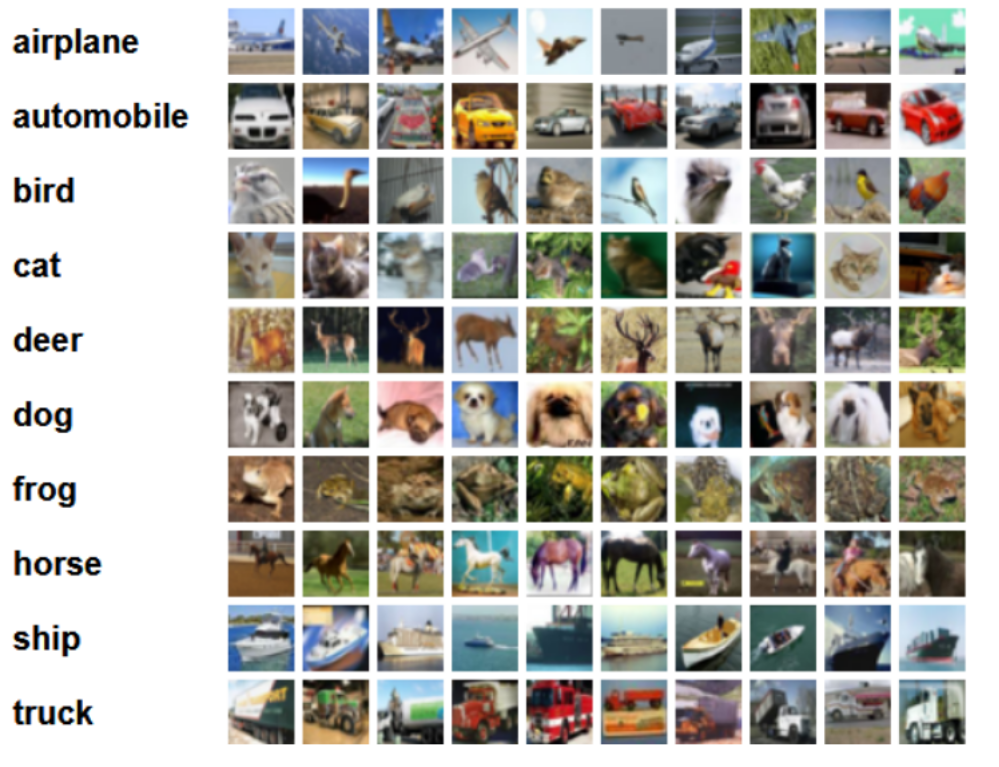CIFAR-10数据集图像分类【PCA+基于最小错误率的贝叶斯决策】
CIFAR-10和CIFAR-100均是带有标签的数据集,都出自于规模更大的一个数据集,他有八千万张小图片。而本次实验采用CIFAR-10数据集,该数据集共有60000张彩色图像,这些图像是32*32,分为10个类,每类6000张图。这里面有50000张用于训练,构成了5个训练批,每一批10000张图;另外10000用于测试,单独构成一批。测试批的数据里,取自10类中的每一类,每一类随机取1000张。抽剩下的就随机排列组成了训练批。注意一个训练批中的各类图像并不一定数量相同,总的来看训练批,每一类都有5000张图。
下面这幅图就是列举了10各类,每一类展示了随机的10张图片:

我的数据集一共有三个文件,分别是训练集train_data,测试集test_data以及标签名称labels_name,而标签名称中共有5个类,‘airplane‘, 'automobile‘, 'bird‘, 'cat‘, 'deer’.我现在准备对前三类‘airplane‘, ’automobile‘, ’bird‘,(即标签为1, 2, 3的数据 )进行分类。
经过之前大量测试,得到在累计方差贡献率为0.79时,基于最小错误率的贝叶斯决策用于图像分类最佳,以下为代码:
#CIFAR-10数据集:包含60000个32*32的彩色图像,共10类,每类6000个彩色图像。有50000个训练图像和10000个测试图像。
import scipy.io
train_data=scipy.io.loadmat("F:\\模式识别\\最小错误率的贝叶斯决策进行图像分类\\data\\train_data.mat")
print (type(train_data))
print (train_data.keys())
print (train_data.values())
print (len(train_data['Data']))
#单张图片的数据向量长度:32X32X3=3072
#内存占用量=3072*4*9968=116M 假定一个整数占用4个字节
print (len(train_data['Data'][0]))
print (train_data)
x = train_data['Data']
y = train_data['Label']
print (y)
print (len(y))
print (y.shape)
print (y.flatten().shape)
#labels_name:共5个标签,分别为airplane、automobile、bird、cat、deer
import scipy.io
labels_name=scipy.io.loadmat("F:\\模式识别\\最小错误率的贝叶斯决策进行图像分类\\data\\labels_name.mat")
print (type(labels_name))
print (labels_name)
print (len(labels_name))
#test_data:共5000个图像,5类,每类1000个图像
import scipy.io
test_data=scipy.io.loadmat("F:\\模式识别\\最小错误率的贝叶斯决策进行图像分类\\data\\test_data.mat")
print (test_data['Label'])
print (test_data['Data'])
print (len(test_data['Label']))
datatest = test_data['Data']
labeltest = test_data['Label']
print (datatest.shape)
print (labeltest.shape)
test_index=[]
for i in range(len(labeltest)):
if labeltest[i]==1:
test_index.append(i)
elif labeltest[i]==2:
test_index.append(i)
elif labeltest[i]==3:
test_index.append(i)
#print (test_index)
labeltest=test_data['Label'][:3000]
#print (labeltest)
import matplotlib.pyplot as plt
from mpl_toolkits.mplot3d import Axes3D
print (x)
print (x.shape)
print (type(x))
from sklearn.discriminant_analysis import LinearDiscriminantAnalysis
from sklearn.decomposition import PCA
pca=PCA(n_components=0.79)
#训练模型
pca.fit(x)
x_new=pca.transform(x)
print("降维后各主成分的累计方差贡献率:",pca.explained_variance_ratio_)
print("降维后主成分的个数:",pca.n_components_)
print (x_new)
index_1=[]
index_2=[]
index_3=[]
index_num=[]
for i in range(len(y)):
if y[i]==1:
index_1.append(i)
elif y[i]==2:
index_2.append(i)
elif y[i]==3:
index_3.append(i)
index_num=[len(index_1),len(index_2),len(index_3)]
print(len(index_1))
print(len(index_2))
print(len(index_3))
print (index_num)
import numpy as np
class1_feature=[]
class2_feature=[]
class3_feature=[]
#index_1
for i in index_1:
class1_feature.append(x_new[i])
print (len(class1_feature))
for i in index_2:
class2_feature.append(x_new[i])
print (len(class2_feature))
for i in index_3:
class3_feature.append(x_new[i])
print (len(class3_feature))
#计算第一类的类条件概率密度函数的参数
class1_feature=np.mat(class1_feature)
print (class1_feature.shape)
miu1=[]
sigma1=[]
for i in range(30):
miu=class1_feature[:,i].sum()/len(index_1)
miu1.append(miu)
temp=class1_feature[:,i]-miu
class1_feature[:,i]=temp
sigma1=(class1_feature.T*class1_feature)/len(index_1)
print (miu1)
print (sigma1)
print (sigma1.shape)
#计算第二类类条件概率密度函数的参数
class2_feature=np.mat(class2_feature)
miu2=[]
sigma2=[]
for i in range(30):
miu=class2_feature[:,i].sum()/len(index_2)
miu2.append(miu)
temp=class2_feature[:,i]-miu
class2_feature[:,i]=temp
sigma2=(class2_feature.T*class2_feature)/len(index_2)
print (miu2)
print (sigma2)
print (sigma2.shape)
#计算第三类类条件概率密度函数的参数
class3_feature=np.mat(class3_feature)
miu3=[]
sigma3=[]
for i in range(30):
miu=class3_feature[:,i].sum()/len(index_3)
miu3.append(miu)
temp=class3_feature[:,i]-miu
class3_feature[:,i]=temp
sigma3=(class3_feature.T*class3_feature)/len(index_3)
print (miu3)
print (sigma3)
print (sigma3.shape)
#计算三个类别的先验概率:
prior_index1=len(index_1)/len(y)
prior_index2=len(index_2)/len(y)
prior_index3=len(index_3)/len(y)
print (prior_index1)
print (prior_index2)
print (prior_index3)
import math
#降维
x_test = pca.transform(datatest)
print (x_test)
print (x_test.shape)
print (x_test[0])
#print ((np.mat(x_test[0]-miu1))*sigma1.I*(np.mat(x_test[0]-miu1).T))
#print (((np.mat(x_test[0]-miu1))*sigma1.I*(np.mat(x_test[0]-miu1).T))[0,0])
predict_label=[]
for i in range(3000):
g1=-0.5*((np.mat(x_test[i]-miu1))*sigma1.I*(np.mat(x_test[i]-miu1).T))[0,0]-0.5*math.log(np.linalg.det(sigma1))+math.log(prior_index1)
g2=-0.5*((np.mat(x_test[i]-miu2))*sigma2.I*(np.mat(x_test[i]-miu2).T))[0,0]-0.5*math.log(np.linalg.det(sigma2))+math.log(prior_index2)
g3=-0.5*((np.mat(x_test[i]-miu3))*sigma3.I*(np.mat(x_test[i]-miu3).T))[0,0]-0.5*math.log(np.linalg.det(sigma3))+math.log(prior_index3)
if g1>g2:
max=1
if g1>g3:
max=1
else:
max=3
else:
max=2
if g2>g3:
max=2
else:
max=3
predict_label.append(max)
from sklearn.metrics import accuracy_score
print (accuracy_score(predict_label,labeltest))
可以看到分类结果的准确率高达73%,这一数值在贝叶斯决策用于图像分类中已经是极值了。

CIFAR-10数据集图像分类【PCA+基于最小错误率的贝叶斯决策】的更多相关文章
- 【翻译】TensorFlow卷积神经网络识别CIFAR 10Convolutional Neural Network (CNN)| CIFAR 10 TensorFlow
原网址:https://data-flair.training/blogs/cnn-tensorflow-cifar-10/ by DataFlair Team · Published May 21, ...
- Python实现鸢尾花数据集分类问题——基于skearn的NaiveBayes
Python实现鸢尾花数据集分类问题——基于skearn的NaiveBayes 代码如下: # !/usr/bin/env python # encoding: utf-8 __author__ = ...
- Python实现鸢尾花数据集分类问题——基于skearn的LogisticRegression
Python实现鸢尾花数据集分类问题——基于skearn的LogisticRegression 一. 逻辑回归 逻辑回归(Logistic Regression)是用于处理因变量为分类变量的回归问题, ...
- Python实现鸢尾花数据集分类问题——基于skearn的SVM
Python实现鸢尾花数据集分类问题——基于skearn的SVM 代码如下: # !/usr/bin/env python # encoding: utf-8 __author__ = 'Xiaoli ...
- 【神经网络与深度学习】基于Windows+Caffe的Minst和CIFAR—10训练过程说明
Minst训练 我的路径:G:\Caffe\Caffe For Windows\examples\mnist 对于新手来说,初步完成环境的配置后,一脸茫然.不知如何跑Demo,有么有!那么接下来的教 ...
- Bunch 转换为 HDF5 文件:高效存储 Cifar 等数据集
关于如何将数据集封装为 Bunch 可参考 关于 『AI 专属数据库的定制』的改进. PyTables 是 Python 与 HDF5 数据库/文件标准的结合.它专门为优化 I/O 操作的性能.最大限 ...
- 10款web前端基于html5/CSS3应用特效
1.jQuery百叶窗效果焦点图 多种百叶窗动画方式 对于百叶窗动画效果,我们介绍的不是很多,目前就介绍过一款CSS3百叶窗图片切换.这次要给大家带来一个基于jQuery的多种百叶窗动画效果焦点图,焦 ...
- DL Practice:Cifar 10分类
Step 1:数据加载和处理 一般使用深度学习框架会经过下面几个流程: 模型定义(包括损失函数的选择)——>数据处理和加载——>训练(可能包括训练过程可视化)——>测试 所以自己写代 ...
- 「从零单排canal 01」 canal 10分钟入门(基于1.1.4版本)
1.简介 canal [kə'næl],译意为水道/管道/沟渠,主要用途是基于 MySQL 数据库增量日志解析,提供增量数据 订阅 和 消费.应该是阿里云DTS(Data Transfer Servi ...
随机推荐
- phpcms中content主要使用的详情列表关系
从首页(index.html)中点开的内容网页叫单网页(page.html) 从列表(list.html)中点开的网页叫内容页(show.html) 从导航栏的栏目中下拉的列表栏目叫栏目列表页(cat ...
- Keystone, Start, Failed to Load Bson
If you have installed the Keystone.js, and properly installed mongodb, but when tried to start the k ...
- Android面试题总结(不定期更新、附答案)
1.Activity的启动模式? activity一共有4种启动模式:standard.singleTop singleTask .singleInstance standard:(标准模式)默认的就 ...
- 根据标签中动态获取的值绑定特定的class
数据有mock数据获取 mock文件: index文件: 引入文件index: 获取数据函数: 根据获取的标签内容给定不同的样式:
- Linux中对逻辑卷进行扩容与缩小
一.在扩容之前,先查看自己逻辑卷,卷组,物理卷的信息:(在上一篇的基础上:Linux中对逻辑卷的建立) 查看物理卷: # pvdisplay /dev/sdc1 查看卷组: vgdisplay /de ...
- zabbix监控tomcat(使用jmx监控,但不使用系统自带模版)
一,zabbx使用jmx监控tomcat的原理分析 1.Zabbix-Server找Zabbix-Java-Gateway获取Java数据 2.Zabbix-Java-Gateway找Java程序(j ...
- c/c++ 标准容器 forward_list resize 操作
c/c++ 标准容器 forward_list, resize, 重新定位迭代器 1,forward_list特有的方法: insert_after emplace_after erase_after ...
- Windows Server 2016-清理残留域控信息
本章紧接上文,当生产环境中域控出现问题无法修复以后,一方面我们需要考虑抢夺FSMO角色,另一方面我们需要考虑的问题是清理当前域控的残留信息,以防止残留数据信息导致用户验证或者解析异常等问题.本章讲到如 ...
- 【PAT】B1004 成绩排名
简单题 循环输入放入结构体数组,一个sort搞定 #include <stdio.h> #include<algorithm> using namespace std; str ...
- Servlet(三):获取表单数据、解决乱码和报错问题
在了解了servlet的生命周期以及运行过程后,再来动手写一个小例子,加深对servlet的理解. 一.需求说明 在用户注册信息页面,输入用户名.密码.性别.邮箱等一些信息后,页面返回刚刚填写的信息. ...
